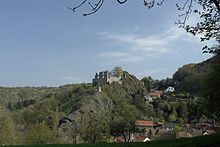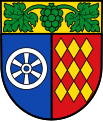County of Falkenstein
The county of Falkenstein was named after the imperial castle Falkenstein in the Palatinate, which was built in the early 12th century.
history
The first bearer of the name of Falkenstein was Philipp I (Falkenstein) from the noble family of the Lords of Bolanden . He inherited in 1258 the Ministerialengeschlecht Münzenberg and thus the bailiwick about the Wetterau and the Reichsvogtei in Dreieich forest . This made the Taunus region the new center of life for the family. In this context, the Hessian castle Falkenstein (Taunus) was named after the noble family Falkenstein , which originally came from the Palatinate. A sideline of this Hessian noble family received the title of count in 1398. The Hessian Falkensteiners died out as early as 1418, and the possessions in the Palatinate came to the Counts of Virneburg via the sister of the last Count .
In 1456 they were given to Wirich (IV.) VI. Sold by Daun-Oberstein , the feudal rights gave Emperor Friedrich III. at Lorraine . After complicated inheritance disputes at the end of the 16th century, it came to the Swedish Count Lewenhaupt zu Raasepori and von Manderscheid -Kail. Wirich (V.) VII. Von Daun-Oberstein († 1546) was finally able to assert himself as lord of the city of Daun and owner of the dominions of Oberstein , Falkenstein, Linnep , Broich and Bürgel and also owned a share in the County of Limburg . Emperor Maximilian I raised the rule of Falkenstein to a county in 1518, whereupon Wirich von Daun and his descendants called themselves the "Lords of Daun-Falkenstein ".
Wilhelm Wirich von Daun-Falkenstein sold the County of Falkenstein in 1667 to Duke Charles IV of Lorraine . With the marriage of Duke Franz Stephan and Maria Theresa of Austria in 1736, the county came to the House of Austria-Lorraine . Since 1782 it has been administered as Oberamt Winnweiler by the front Austrian government in Freiburg im Breisgau .
scope
- The core of the area around Falkenstein included the area that encompassed today's communities of Winnweiler with Hochstein , Potzbach and Schmelzhütte, Schweisweiler , Falkenstein , Imsbach , Höringen , Lohnsfeld , Börrstadt and Steinbach .
- To the north was the property complex of St. Alban with Gerbach and Gaugrehweiler .
- The villages of Bayerfeld , Cölln , Dielkirchen , Steckweiler and Steingruben (later lost to Zweibrücken) were located on the Alsenz as a Stolzenberger community with the Duke of Zweibrücken .
- Via Ilbesheim , Hohen-Sülzen , Framersheim , Hillesheim and Dalheim , Falkensteiner's free float reached shortly before the city of Mainz ; with Eckelsheim , Biebelsheim and Kalkofen , further free float pointed to the Palatinate office of Neubamberg .
- In the south, the rulership of Wilenstein with Trippstadt , Stelzenberg and Mölschbach was also part of it.
Before the First Coalition War (1792) it had around 125 km² with 7714 inhabitants; It is unclear why in the tables of Baron von Lang for 1798 only 4200 inhabitants are noted. After the Left Bank of the Rhine belonged to France between 1794/97 and 1814, Austrian rule was only briefly restituted, until in 1816 most of it came to Bavaria to the Rhine district and some communities to Rheinhessen ( province of the Grand Duchy of Hesse ). Since 1946 all places of the former Oberamt Winnweiler belong to Rhineland-Palatinate .
Governing lords and counts
- Lords and Counts of Bolanden-Falkenstein
- before 1233–1298 Philip I (IV.) von Bolanden-Falkenstein (* around 1200, † 1271), married to Isengard von Münzenberg
- 1271–1298 / 1300 Philip II (V.) von Falkenstein-Münzenberg-Butzbach († 1293/95) and Werner I von Falkenstein-Münzenberg-Lich (* 1234/37; † 1298/1300); 1271 First Falkenstein division
- 1293 / 1300-1322 Philip III. (VI.) Von Falkenstein-Münzenberg (* around 1257, † 1322), treasurer, grave slab in the Marienstiftskirche Lich , and his son Philipp IV. Von Falkenstein-Münzenberg (* around 1272, † 1312)
- 1322–1333 Kuno II von Falkenstein-Münzenberg († 1333), grave slab in the Marienstiftskirche Lich
- 1333–1343 Philip V of Falkenstein-Münzenberg († 1343)
- 1343–1349 under the tutelage of Kuno (III.) Von Falkenstein-Münzenberg (* around 1320; † 1388), as Kuno II. Archbishop of Trier, wall grave in the Basilica of St. Kastor in Koblenz
- 1349-1370 / 73 Philip VI. von Falkenstein-Münzenberg (* around 1320; † 1370/73)
- 1370 / 73–1407 Philip VII of Falkenstein-Münzenberg († 1410), raised to the rank of count in 1398, resigned in 1407, and Philip VIII of Falkenstein-Münzenberg († 1407), epitaphs in the Markuskirche Butzbach
- 1407-1418 in the guardianship of Werner von Falkenstein (* around 1355, † 1418), as Werner III. Archbishop of Trier, high grave in the Basilica of St. Kastor in Koblenz, for his nieces, the descendants of Luitgard von Falkenstein (* around 1357, † after 1391), married to Eberhard I. von Eppstein , and Agnes von Falkenstein (* around 1358, † 1409), married to Otto I. von Solms-Braunfels
- Counts of Virneburg
- 1418–1444 Ruprecht IV. Von Virneburg († 1444), married to Agnes von Solms († 1412/20), daughter of Otto I. von Solms-Braunfels; 1420 Second Falkenstein division under Sayn, Virneburg, Solms, Isenburg, Eppstein and Hanau
- 1444–1456 Wilhelm von Virneburg-Falkenstein († 1487), sold the county
- Counts of Daun-Oberstein
- 1456-1501 Wirich (IV.) VI. von Daun-Oberstein (1418–1501), tombstone in the Otterberg Abbey Church
- 1501–1517 Melchior von Daun-Oberstein (1445–1517), tombstone in the Otterberg Abbey Church, married to Margaretha von Virneburg
- 1517–1530 Philipp von Daun-Oberstein († 1530), Falkenstein was raised to an imperial county by Emperor Maximilian I in 1518 , tombstone in the Otterberg Abbey Church
- 1530–1546 Wirich (V.) VII. Von Daun-Falkenstein († 1546)
- 1546–1579 Johann von Daun-Falkenstein (1506–1579), also as guardian of his mentally weak brother Kaspar († 1576), enfeoffed in 1549 by the widow Duchess Christina of Lorraine , in 1554 through an inheritance agreement with his brothers Philip II of Daun-Falkenstein- Broich (* around 1514; † 1554) and Sebastian von Daun-Oberstein (* around 1530; † around 1576) confirmed. The county's imperial status was confirmed by Emperor Ferdinand I in 1559 . Tomb in the Marienthal monastery church
- 1579–1585 reign of the widow, Countess of the Rhine and Wildlife, Ursula zu Salm-Kyrburg (1515–1601), who was married to Ruprecht von Pfalz-Zweibrücken-Veldenz († 1544) for the first time
- 1585–1615 Sebastian von Daun-Falkenstein-Oberstein (* around 1546; † 1615), grave slab in the rock church Oberstein . His sister Sidonia von Daun-Falkenstein (1549–1588) had been married to Axel Stensson Lewenhaupt-Raasepori (1554–1619) since 1579
- 1615–1628 Emich IV. Von Daun-Falkenstein-Oberstein († 1628), tomb in the Marienthal monastery church
|
Daun-Falkenstein-Oberstein
|
Lewenhaupt-Rasburg (inheritance claim)
|
- Condominium of the Counts of Manderscheid-Kail and Lewenhaupt
|
Manderscheid-Kail
|
Lewenhaupt-Rasburg
|
- 1660/67 Charles IV of Lorraine
- 1667 / 68–1682 (claim to 1723) Charles Henri de Lorraine-Vaudémont (1649–1723). By a judgment of the Reunionskammer Metz in 1682 the Counts of Manderscheid and Lewenhaupt were initially returned to the County of Falkenstein.
|
Manderscheid-Kail
|
Lewenhaupt-Rasburg
|
- House of Habsburg-Lorraine
- 1723 / 24–1729 Leopold of Lorraine
- 1729–1765 Franz Stephan von Lothringen , enfeoffed with the imperial fief of the County of Falkenstein in 1731, married to Maria Theresa of Austria since 1736 , elected Roman-German Emperor in 1745
- 1765–1790 Joseph II of Habsburg-Lothringen , Holy Roman Emperor
- 1790–1792 Leopold von Habsburg-Lothringen , Holy Roman Emperor
- 1792–1794 Franz II of Habsburg-Lothringen , Holy Roman Emperor
Burgraves, administrators and officials (senior officials) of the County of Falkenstein
- 1320, 1330 Gerhard von Wachenheim
- 1350 Peter von Wachenheim
- 1409, 1413 Johann (Henne) von Lewenstein called von Randeck
- 1466, 1469 Arnold Glock (bell) von Oberstein († after 1478) from an electoral trier family of castle people from St. Wendel
- 1480 Bligger XIV. Landschad von Steinach († 1499), Burgrave of Alzey, married to Mia von Helmstadt, double tomb in the newly built church in Neckarsteinach
- 1484 Peter von Gersbach
- 1537 (Hans) Christoph II. Landschad von Steinach
- 1541, 1545, 1546 Bleickard XVI. Landschad von Steinach
- 1554 Hans Martin von Wachenheim, brokered the inheritance agreement between the von Daun-Falkenstein brothers in 1554
- 1577 Friedrich von Lewenstein
- 1620, 1629 Johann Henrich Keßler von Sarmsheim
- 1665/67 Johann Christoph von Schellart, in 1665 the ducal Lorraine chief magistrate zu Falkenstein von Schellart was accepted into the Upper Rhine Imperial Knighthood
- Johann Daniel Mörlin (von Morle) (1641–1699), councilor of Duke Charles IV and Prince Charles Henri de Lorraine-Vaudémont and senior magistrate of the County of Falkenstein
|
Falkenstein-Manderscheid-Kail
|
Falkenstein-Lewenhaupt
|
- 1728, 1729, 1730 Baron Franz Friedrich von Langen, 1720 Electoral Mainz Chamberlain and Councilor
- 1740–1753 Johann Nikolaus von Schackmin
- 1756 Bernhard Anton Emanuel von Brée (Landschreiber), 1764 Imperial Knighthood
- March 2, 1770–1772 Friedrich Karl von Moser (administrator)
- 1784 Joseph Philipp Sauer, (Administrator of the Imperial County of Falkenstein)
- 1785- 1797 Joseph Innocenz von Steinherr, Edler von Hohenstein (1751–1824), (1785 provisional administrator, 1786–1797 kk Oberamtmann)
coat of arms
The coat of arms of the Counts of Falkenstein shows a silver, six-spoke winding wheel in blue . It still appears today in a number of current municipal coats of arms in Rheinhessen and the Palatinate, z. B .:
Family coat of arms of those of Falkenstein
Varia

Emperor Joseph II basically used the title of "Count of Falkenstein" when he traveled incognito.
literature
-
Jacob Wilhelm Imhoff : De Comitibus a Falckenstein . In: Notitia S. Rom. Germanici Imperii procerum . 3rd edition Cotta & Brunnius, Tübingen 1693, p. 292f ( Google Books )
- Jacob Wilhelm Imhoff, Johann David Köhler : Notitia Sacri Romani Germanici Imperii Procerum tam Ecclesiasticorum quam Secularium historicoheraldico-genealogica , Vol. II. 5th ed. Cotta, Tübingen 1734, pp. 184-186 ( Google Books )
- Anonymous: Genealogia Dominorum Falckensteinensium a Seculo XII usque ad excessum Gentis Dhunensis . o. O. 1745 ( digitized version of the Bavarian State Library in Munich), ( Google Books )
- Ludwig Albrecht Gebhardi : History of the count's houses Falkenstein . In: Genealogical history of the hereditary imperial estates in Germany . Gebauer, Halle 1776, pp. 597–704 ( Google Books )
- Gabriel Anrep (Ed.): Svenska adelns ättar-taflor , Vol. II / 1. Norstedt, Stockholm 1861, pp. 664–677 ( Google Books )
- Johann Georg Lehmann : Documented history of the lords and counts of Falkenstein at the Donnersberge in the Palatinate . o. O. 1871 ( Google Books )
- Gerhard Köbler : Historical lexicon of the German countries. The German territories from the Middle Ages to the present. 7th, completely revised edition. CH Beck, Munich 2007, ISBN 978-3-406-54986-1 , p. 181 ( limited preview in the Google book search).
- Kurt Oberdorffer : The imperial county Falkenstein. In: Friedrich Metz (Hrsg.): Vorderösterreich - a historical regional studies. 3rd edition 1977, pp. 565-578, ISBN 3-7930-0208-X
- Thorough and detailed report What about their, in the H: Röm: Reich located Immediat Graffschaff Falckenstein…. [S. l.], 1663 ( online Uni Augsburg )
- Adolph Köllner: History of the lordship of Kirchheim-Boland and Stauf , Wiesbaden, 1854, contribution " An attempt at a history of the county of Falkenstein am Donnersberg and its former owners ", pp. 368-414 ( Google Books )
Individual evidence
- ↑ a b Gabriel Anrep (Ed.): Svenska adelns ättar-taflor , Vol. II / 1. Norstedt, Stockholm 1861, pp. 664f.
- ↑ Gabriel Anrep (Ed.): Svenska adelns ättar-taflor , Vol. II / 1. Norstedt, Stockholm 1861, p. 665.
- ↑ a b Gabriel Anrep (Ed.): Svenska adelns ättar-taflor , Vol. II / 1. Norstedt, Stockholm 1861, p. 677.
- ↑ Cf. Leopold Nedopil: German nobility samples from the German Order Central Archive . Braumüller, Vienna 1868, p. 594 ( Google Books ).
- ↑ Gabriel Anrep (Ed.): Svenska adelns ättar-taflor , Vol. II / 1. Norstedt, Stockholm 1861, pp. 665f.
- ↑ Gabriel Anrep (Ed.): Svenska adelns ättar-taflor , Vol. II / 1. Norstedt, Stockholm 1861, pp. 666f.
- ↑ a b c d Gabriel Anrep (Ed.): Svenska adelns ättar-taflor , Vol. II / 1. Norstedt, Stockholm 1861, p. 670.
- ↑ Gabriel Anrep (Ed.): Svenska adelns ättar-taflor , Vol. II / 1. Norstedt, Stockholm 1861, p. 676.
- ^ Contract between the Hertzog zu Lorraine and Count Wolf Heinrich zu Manderscheid because of the Counts of Falckenstein , dd 1724. June 14th In: Johann Jacob Moser (Hrsg.): Diplomatic Archive of the XIIX. Century . Reinhard Eustacius Möller, Frankfurt am Main 1743, No. 48, pp. 447-459 ( Google Books ).
- ↑ a b Gabriel Anrep (Ed.): Svenska adelns ättar-taflor , Vol. II / 1. Norstedt, Stockholm 1861, p. 666.
- ↑ a b Gabriel Anrep (Ed.): Svenska adelns ättar-taflor , Vol. II / 1. Norstedt, Stockholm 1861, p. 667.
- ↑ a b Gabriel Anrep (Ed.): Svenska adelns ättar-taflor , Vol. II / 1. Norstedt, Stockholm 1861, p. 671.








